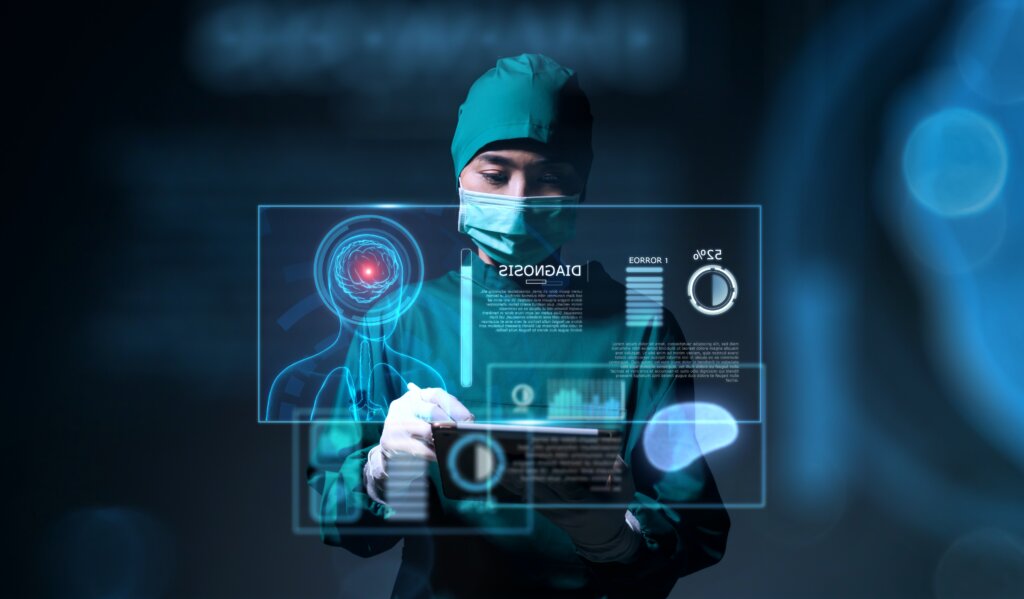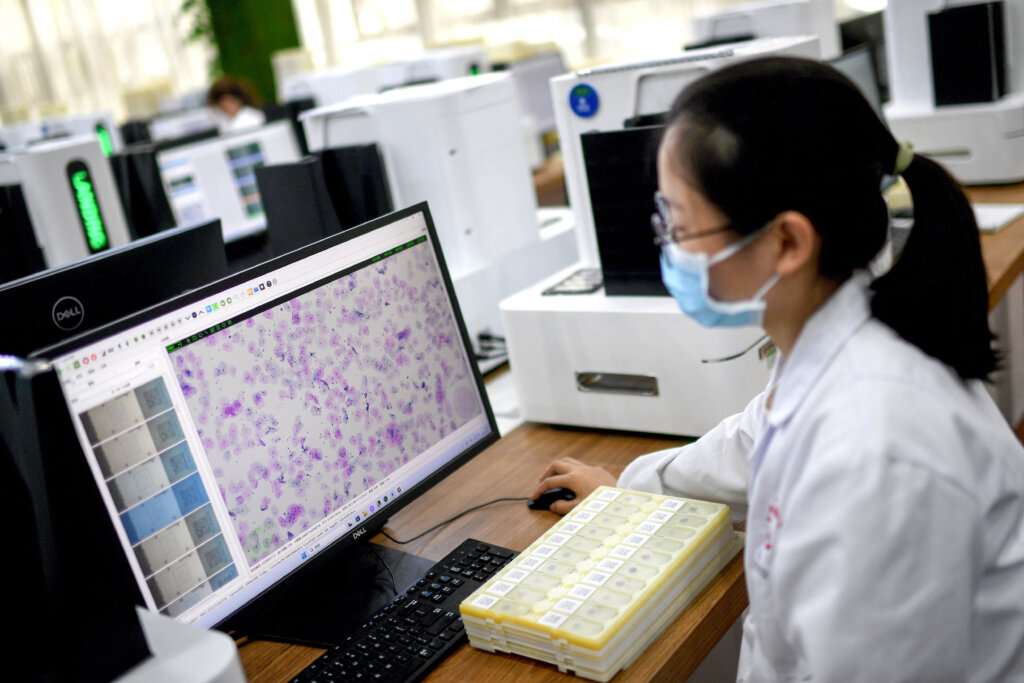
Could AI eventually replace doctors? (Image – Shutterstock)
Emerging technologies: AI in the healthcare industry
• The use of AI in healthcare is increasing rapidly.
• AI is improving cancer diagnosis speeds significantly.
• But for now, it remains a clinician-assisting technology.
Artificial intelligence (AI) in the healthcare industry continues to see new innovations in a range of use cases.
While the early use of AI in healthcare aimed more towards enhancing medical practice, new use cases for generative AI are actively expanding the industry’s capabilities.
According to a report by IDC, generative AI is set to hyper-personalize care services in the Asia Pacific by up to 49.6%. Healthcare providers are planning to invest in more generative AI use cases, especially to augment clinician efficiency and redefine patient experiences.
Currently, the top generative AI use cases for Asia Pacific healthcare organizations include marketing, knowledge management, and conversational applications. The report also emphasizes the necessity for “explainability” in the context of Generative AI use case adoptions in healthcare, since diagnoses and treatment plans generated by AI tools significantly impact patients’ lives.
In fact, healthcare organizations in the region are cognizant of the need for ethical aspects. According to the FERS survey, 61% of healthcare organizations in the region are adopting data ethics requirements, while 14% already adhere to ethical data aspects in their operations.
“Generative AI use cases are being adopted across industries. In healthcare, generative AI has immense potential in addressing inherent challenges to increase productivity, attain hyper-personalization and enhance physician/patient experience by leveraging the capabilities of large language models (LLMs). It is imperative that the healthcare organizations be compliant and ensure explainability while adopting such new wave AI tools”, commented Manoj Vallikkat, senior research manager, IDC Asia Pacific Healthcare Insights.

AI has been a gamechanger in the healthcare industry. (Image – Shutterstock)
AI in healthcare: Patient diagnosis and early detection
Looking specifically at AI research by Imperial College London, Dr. Aldo Faisal, leader of the Center for Doctoral Training in AI for Healthcare, believes AI addresses the growing clinical care demand. Dr. Faisal divides AI for healthcare into two broad categories. The first is Perceptual AI, which replicates the ability of healthcare professionals to perceive disease through diagnosis and monitoring. The second is Intervention AI, which addresses decisions about how patients should be treated.
Assisting in patient diagnosis and early detection are two of the most common medical use cases for AI in the healthcare industry. There are already several tech providers enabling patient diagnosis in medical centers around the world.
For example, IBM’s Watson for Health enables cognitive technology to unlock vast amounts of health data and power diagnosis. The tool can not only review and store vast amounts of medical information but also quickly harness data from global case study treatments.
Another example is Google’s DeepMind Health. A PwC report mentions that Google collaborates with clinicians, researchers, and patients. Its goal is to address real-world healthcare issues by integrating machine learning with systems neuroscience, thereby building robust, general-purpose learning algorithms into neural networks that resemble the human brain.

Some of the AI use cases identified for healthcare.
When it comes to early detection, AI continues to work wonders in cancer research and detection. For cancer, early detection can make a huge difference to a person’s prognosis. The Guardian reported that doctors, scientists and researchers have built an AI model that can accurately identify cancer. The team believes this can speed up the diagnosis of the disease and fast-track patients to treatment.
Designed by researchers at the Royal Marsden NHS Foundation Trust, the Institute of Cancer Research, London, and Imperial College London, the AI tool can identify whether abnormal growths found on CT scans are cancerous. The algorithm performs more efficiently and effectively than current methods, according to a study.
Over in Malaysia, Ramsay Sime Darby Health Care (RSDH), has partnered with Amazon Web Services (AWS), and Annalise.ai, one of the largest radiology AI solution providers, to deploy AI-powered clinician-assisting tools, Annalise Enterprise chest X-ray (CXR).
Designed to help patients obtain the right care promptly, Annalise Enterprise CXR uses proprietary deep-learning algorithms to help clinicians identify the suspected presence of up to 124 issues in chest X-ray findings in less than 20 seconds. The AI solution serves as a precision tool for the medical team at RSDH’s hospitals, enhancing clinicians’ ability to discern subtle details in medical images.
Leveraging AWS’s scalable, resilient, and cost-effective cloud infrastructure, this AI deployment marks the first AWS cloud installation of its kind in Malaysian hospitals. The solution is expected to deliver findings faster to RSDH’s radiologists and represents a significant step forward in the adoption of cloud and AI-powered medtech in the region.

Medical practitioners can have faster access to patient data with AI. (Image – Shutterstock)
AI in healthcare: Vaccine research
In Japan, Nagasaki University and NEC OncoImmunity (NOI), a leading AI company, will collaborate to use NOI’s AI platform to design universal vaccines to combat highly pathogenic and tropical infectious diseases. Harnessing the power of advanced AI, the university hopes to optimize vaccine designs that are universally protective against specific pathogen families common in tropical regions.
Under the scope of the collaboration, AI technology from NOI will be used to design both T-cell and B-cell vaccines. Nagasaki University will then validate the designs using its robust “wet lab” capabilities and convalescent donor samples gathered from its wide network of tropical field stations.
This collaboration has also led to the establishment of the Vaccine Informatics Department at the Institute of Tropical Medicine, Nagasaki University. The department, led by Dr. Trevor Clancy, Chief Scientific Officer of NOI, will employ its AI technology to support the Nagasaki University team in conducting basic research aimed at understanding the immune correlates of protection across a range of tropical diseases. Members of NEC’s AI drug development team will also participate in this department.
Richard Stratford, CEO of NOI, expressed his enthusiasm about the collaboration, saying the company is fully committed to delivering effective vaccine designs to Nagasaki University that target highly pathogenic and tropical infectious diseases.

This photo, taken on June 15, 2023 shows a laboratory technician conducting artificial intelligence (AI)-based cervical cancer screening at a test facility in Wuhan, in China’s central Hubei province. (Photo by AFP)
The AI clinician
Besides patient diagnosis, early detection, and research, Dr. Faisal believes there are numerous use cases for intervention AI. His team has already developed an AI clinician which can be applied to diabetes management, neurological disorders and also to intensive care.
In intensive care, the AI monitors data collected to maximize the patient’s chances of survival. However, there will still be human intervention when the final data is made available. It will only give advice to doctors, which is also why explainability is of paramount importance.
“The machine has to say why it is making a recommendation and convince the doctor why it is the right thing to do,” said Dr Faisal. The system is currently being installed and prepared to be tested in a hospital in London.
Technologies emerging alongside AI in healthcare
As AI adoption in healthcare proliferates, healthcare institutions are also exploring other emerging technologies. For instance, robots are anticipated to play a pivotal role in healthcare’s future, particularly addressing worker shortages in certain regions.
For example, a healthcare robot can help provide patient medication or even check the patient’s status and reporting it back to the doctor. Some hospitals around the world have already started using robots to help with patient care, especially in non-clinical work like providing food to patients and cleaning.
Another development is healthcare within the metaverse. Just like virtual clinics, healthcare in the metaverse would be an extension of telemedicine. Last year, Zuellig Pharma Digital & Data introduced ZP Metaverse, a groundbreaking healthcare metaverse experience that improves current telemedicine by connecting its “plant-to-patient” digital twin and merging B2B and B2C experiences.
Who should be responsible?
The increasing use of AI and other emerging technologies in healthcare has also caused some concern. Notably, two main areas should be addressed. Firstly, there’s the security of the data collected and utilized by AI. As generative AI tools deal with a lot of sensitive healthcare data, the data should be collected, stored and analyzed effectively by the healthcare and technology provider.
The second concern is cybersecurity. The amount of data being generated by increasing AI tools means that cybercriminals will find ways to infiltrate systems to get access to medical data. Statistics show that 30% of large data breaches occur in hospitals. Security Intelligence reported that the average cost of a healthcare data breach was the highest among all industries, at US$10.93 million. The healthcare industry has also seen a significant cost increase of 53.3% over the past three years.
The report highlighted that it typically takes 231 days to discover healthcare data breaches, compared to an average of 204 days in other industries. The healthcare industry experienced longer containment periods, an average of 92 days compared with other industries at 73 days. Healthcare organizations took an average of 19 days longer to contain a data breach.
While data protection and cybersecurity in healthcare have improved, increasing use of technology requires the continuous updating of security protocols.
Lastly, even as the healthcare industry accelerates its adoption of technology, including AI, it’s crucial to remember that the ultimate decision regarding patient welfare should rest with the doctor, not the technology – at least for the foreseeable future. Patients themselves are becoming more accepting of these technologies in their care plans. As such, healthcare institutions should ensure that the technology used is well planned and will not end up being a burden to both patient and doctor.
READ MORE
- Safer Automation: How Sophic and Firmus Succeeded in Malaysia with MDEC’s Support
- Privilege granted, not gained: Intelligent authorization for enhanced infrastructure productivity
- Low-Code produces the Proof-of-Possibilities
- New Wearables Enable Staff to Work Faster and Safer
- Experts weigh in on Oracle’s departure from adland






